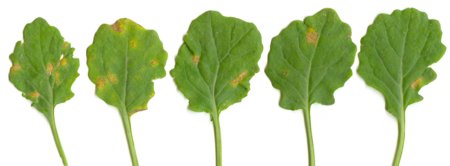Diseases
Peronospora brassicae Gaum. - Downy Mildew of Cabbage, Peronosporosis.
Systematic position.
Class Oomycota, order Peronosporales, family Peronosporaceae, genus Peronospora.Biological group.
Obligate parasite.Morphology and biology.
Disease appears on plants in all periods of their development, but damaging especially strongly sprouts and seed crops. Grayish mealy bloom consisting of sporiferous fungus appears on cotyledons and leaves of sprouts as separated or coalesced spots on the lower side of a leaf. Pale yellow diffused spots are visible on the upper side of leaves. Diseased leaves turn yellow, dying off at strong lesion. Leaves, stalks, pedicels, and pods are affected on seed crops; plants are covered with white mealy bloom, under which the tissue is depressed and darkened. Seeds in the diseased pods become dim and puny. These seeds produce the diseased shoots bearing diffused mycelium inside. During the cabbage storage time the disease can develop on external leaves of heads, covering them with grayish blurred spots with albesent bloom, and causing the decay of head.s heart. Such parent plants produce diseased seed bushes infecting later the neighboring plants. Conidiophores are dichotomously ramified, 250-450 x 6-9 microns in size, located by 1 or 2. Conidia are elliptic, 12-28 x 11-23 microns, with thin colorless coat. Oogonia have thick coat, 35-50 microns in diameter; oospores are spherical, 25-30 microns in diameter. The agent affects cabbage, swede, turnip, garden radish, and other cruciferous plants.Distribution.
Disease is found in the Western Europe, Northern America. In the former USSR it is registered everywhere. Strong affection of plants, seed plants, and seeds is reported in all territory of the Northwestern zone of Russia, as well as in Central and Volga-Vyatka regions and some areas of Chernozem region (Tambov, Lipetsk and Voronezh), in Krasnodar Territory, Crimean, Kharkov, and Tashkent Regions, and in Eastern Georgia.Ecology.
Micelium of the fungus keeps viability in cabbage seeds to 6 years. In southern areas of seed-farming the affection of seeds is favored with rich precipitation (75-80 mm during seed formation), average daily temperature 19-23.C, and relative air humidity at least 75%, and also photophase 14-15 hours; in northern areas the affection is favored with rich precipitation, average daily temperature 10-15.C, and relative air humidity 80-90%, and the same photophase (14-15 hours).Economic significance.
In some unfavorable years the disease infects to 50-60% seeds of cabbage; therefore the yield reduces by 16-20%, and the yield losses are 30-60 centers per hectare on parent crops of cabbage. 30 to 100% sprouts become affected by peronosporosis. Sometimes 32-100% of seed crops are infected. Control measures include collection of seeds from healthy seed crops; their disinfection before sowing; disinfection of hotbeds; treatment of sprouts in hotbeds and on fields by chemical preparations; normal thickness of sowing and airing of hotbeds; removal of all afterharvesting residues; careful survey of seedlings before planting in field; crop rotation; cultivation of resistant varieties.Related references.
Anisimov A.M. 1972. Grounds of fungal and bacterial diseases control system on cabbage in Left-Bank Ukraine. PhD Thesis. Kiev: Ukrainian Agricultural Academy. 51 pp. (in Russian).Bilai V.I., ed. 1988. Microorganisms . agents of plant diseases. Kiev: Naukova dumka. 550 pp. (In Russian)
Dolidze M.I., Meladze E.I. 1980. Cabbage diseases in Eastern Georgia. In: Materials of the Transcaucasian coordination meeting on plant protection (May, 15-16 1980). Tbilisi: 62-63. (In Russian)
Hawksworth D.L., Kirk P.M., Sutton B.C., Pegler D.M. 1995. Ainsworth & Bisby.s Dictionary of the fungi. CAB International. 616 pp.
Ibragimov G.R., Mustafaev B.A. 1967. Diseases of cabbage growing in open and closed ground and their control. In: Proceedings of Azerbaijan research institute of vegetable growing, Baku. V.1: 200-205. (In Russian)
Kupriyanova V.K. 1957. Biological features of Peronospora brassicae Gaumann. Botanicheskii zhurnal 42(5): 760-763. (In Russian)
Kupriyanova V.K. 1958. Peronosporosis and other diseases of seed cabbage and their control. In: Proceedings of Leningrad Agricultural Institute, Leningrad. V. 13: 196-202. (In Russian)
Osnitskaya E.A. 1969. Diseases of vegetables. In: Pests and diseases distribution on agricultural crops in RSFSR in 1968 and the forecast of their appearance in 1969. Moscow: Rosselkhozizdat: 137-144. (In Russian)
Shevchenko I.S. 1963. Diseases of tomatoes and cabbage in northern part of Volga-Akhtuba valley. In: Chulkov N.I., ed. Collection of works of the Volgograd experimental station. Volgograd: Volgograd Publishing House. V.3: 144-153. (In Russian)
Tunkina T.V. 1955. Peronospora fungi of griby Apsheron. In: Barkalov T.O., ed. Proceedings of Botanical Institute, Baku: AN AzSSR. V.19: 67-111. (In Russian)
Vasil.eva E.D. 1976. Severity of peronosporosis of cabbage efficiency of its control by polycarbacine. In: Proceedings of Leningrad Agricultural Institute. Plant protection against pests and diseases. Leningrad, V. 297: 97-100. (In Russian)
Vladimirskaya M.E., Chumakov A.E. 1971. Downy Mildew of Cabbage. In: Methods of the territorial long-term forecast of plant diseases. Leningrad: VIZR: 44-45. (In Russian)
© Khlopunova L.B.


